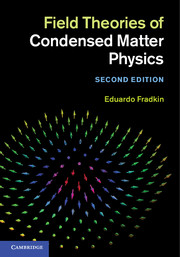Book contents
- Frontmatter
- Contents
- Preface to the second edition
- Preface to the first edition
- 1 Introduction
- 2 The Hubbard model
- 3 The magnetic instability of the Fermi system
- 4 The renormalization group and scaling
- 5 One-dimensional quantum antiferromagnets
- 6 The Luttinger liquid
- 7 Sigma models and topological terms
- 8 Spin-liquid states
- 9 Gauge theory, dimer models, and topological phases
- 10 Chiral spin states and anyons
- 11 Anyon superconductivity
- 12 Topology and the quantum Hall effect
- 13 The fractional quantum Hall effect
- 14 Topological fluids
- 15 Physics at the edge
- 16 Topological insulators
- 17 Quantum entanglement
- References
- Index
15 - Physics at the edge
Published online by Cambridge University Press: 05 March 2013
- Frontmatter
- Contents
- Preface to the second edition
- Preface to the first edition
- 1 Introduction
- 2 The Hubbard model
- 3 The magnetic instability of the Fermi system
- 4 The renormalization group and scaling
- 5 One-dimensional quantum antiferromagnets
- 6 The Luttinger liquid
- 7 Sigma models and topological terms
- 8 Spin-liquid states
- 9 Gauge theory, dimer models, and topological phases
- 10 Chiral spin states and anyons
- 11 Anyon superconductivity
- 12 Topology and the quantum Hall effect
- 13 The fractional quantum Hall effect
- 14 Topological fluids
- 15 Physics at the edge
- 16 Topological insulators
- 17 Quantum entanglement
- References
- Index
Summary
In an incompressible quantum fluid, such as the Laughlin state, the fluctuations in the bulk induce fluctuations at the boundary. While the local fluctuations in the bulk are associated with local changes in the density, the fluctuations of the states at the boundary are associated with changes in the shape of the “droplet” of the electron fluid, shown in Fig. 15.1. These “edge waves” are the only gapless excitations of the system. It may seem surprising that an incompressible fluid may have gapless modes at the surface, although this is quite common in conventional fluids such as water! In the FQHE the gaplessness arises from the fact that the geometric edge of the fluid coincides with the locus of points in which the Fermi energy crosses the external potential which confines the fluid. Thus, the boundary of the fluid behaves like a “Fermi surface” and, as we move from the edge and into the bulk, we get deeper and deeper in the Fermi sea of occupied states. Because of the presence of the magnetic field, the edge waves are chiral excitations that move at the drift velocity of the particles at that point. Thus, edge states move only in one direction, which is specified by the magnetic field. The importance of the edge states to the observability of the quantum Hall effect was first emphasized by Halperin (1982). The description of the chiral quantum dynamics of the edge states is due to X. G. Wen (Wen, 1990a, 1990b, 1991b) and M. Stone (Stone, 1991).
Edge states of integer quantum Hall fluids
Let us consider the physics of the edge waves in the context of the simplest system: non-interacting electrons filling up the lowest Landau level (ν = 1). Strictly speaking, we are discussing the behavior of the edge states in a system with an integer quantum Hall effect (IQHE). However, at least within a mean (or average)-field approximation, the fractional quantum Hall effect can also be regarded as an IQHE of an equivalent system of fermions. We will discuss this point of view (originally due to Jain) in this chapter, where we present the Chern–Simons approach to the FQHE. In this section we follow the methods of Stone (1991).
- Type
- Chapter
- Information
- Field Theories of Condensed Matter Physics , pp. 603 - 668Publisher: Cambridge University PressPrint publication year: 2013



